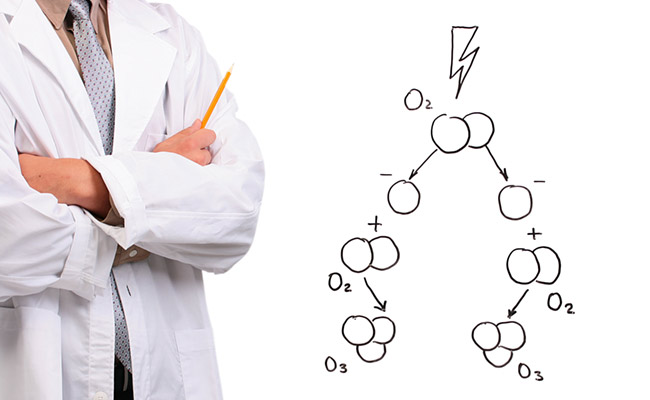
Ozone is O3 (three atoms of oxygen instead of two) and is considered a “super oxygen”. Ozone is a very effective, naturally occurring disinfectant that kills bacteria, fungus, viruses, and parasites. Ozone has extensive applications in modern dentistry.
At Carrollton Smiles, we utilize ozone to disinfect the tooth surface before receiving a filling or a crown. Dental Ozone is also used to hasten healing after deep cleaning. Ozone is used to disinfect the canals during root canal treatment.
Ozone has tremendous benefits while treating lichen planus of the mouth. It can also be used to desensitize teeth and increase the effectiveness if teeth whitening.
Atmospheric Ozone is used to determine the level of pollution in air. The ozone itself is not toxic, but the negatively charged radicals binding with the environmental pollutants is what makes the air unsafe.
Dental Ozone is made when medical grade oxygen, the “Pure Oxygen”, is passed through an ozone generator and is electrically activated to form ozone (O3). The concentration of ozone generated is dependent on the requirements your dentist sets. The strength and frequency of ozone treatment is determined by your dentist based on the severity of your condition.
Ozone is used in gas form that is generated chairside by your dentist using medical grade oxygen and a medical grade ozone generator. It is applied directly to the cavity or surgical site. It sometimes is injected into site as bactericidal.
Alternatively, it is dispensed as ozonated water. This is used to disinfect root canals, irrigate the extraction socket, or disinfect the surgical site prior to dental implant placement.
Your dentist may choose to send you home with ozonated oil to place on gums after a crown preparation, after deep cleaning, or if you have a canker sore. The mode of delivery is specific to the condition being treated.
Ozone therapy in the form of ozonated water, ozonated oil, and ozone gas have beneficial effects in treatment of periodontitis and gingivitis. Your dentist may choose to irrigate the gums and periodontal pockets with ozonated water after the dental cleaning or deep cleaning. In addition to this, you may be prescribed ozone oil to help improve the health of your gums. The improvement in the health of the periodontal status is due to decreased load of gram positive and gram negative bacteria in the pockets.
Ozone can be used to disinfect the tooth surface before placing fillings and crowns on teeth. If you have sensitivity after having a filling placed, your dentist may choose to apply ozone to the teeth. This not only eliminates sensitivity but also disinfects the tooth surface prior to restoration.
Some dentists choose to use ozone to disinfect the tooth surface prior to placing sealants on children’s teeth. This disinfects the tooth surface and prevents cavities forming under the sealants.
Sensitive teeth are not only inconvenient but also painful to deal with. If you have sensitive teeth after your dental cleaning is completed, an ozone treatment may be prescribed to you. The gaseous ozone is applied to the teeth for the prescribed amount of time and a topical fluoride may be applied to the teeth. This protocol of applying ozone to eliminate root sensitivity has been shown to be effective, as the smear layer is completely removed. This elimination of smear layer aids in plugging of the dentinal tubules with fluoride forming fluorapatite.
When playing contact sports, a lot of the kids inadvertently get hit in the mouth which can result in either a broken tooth or root canal treatment. Either of these situations will result in discolored teeth. Ozone can be used to eliminate discoloration. Some people have sensitive teeth which makes it hard to whiten the teeth. Ozone can be applied to the teeth prior to whitening to minimize the sensitivity.
Alternatively, your dentist may choose to agitate the whitening gel during the procedure to improve the effect of the procedure. This procedure is also used prior to a smile makeover to block out & eliminate the darker stains on the teeth. Doing the ozone teeth whitening will reduce the chances of the discolored tooth showing through the all porcelain crowns.
Ozonated water is used to improve healing of oral tissues after a surgical procedure. It can be used to irrigate the extraction site to disinfect the area. It has been shown that using ozonated water, gaseous ozone and ozonated oils help healing. Your dentist may also give you ozonated ice cubes to eat to enhance healing.
Ozone gas and ozonated water have been proven to disinfect the root canal system before finishing the root canal treatment. Your dentist or root canal specialist may choose to irrigate the root canals with ozonated water or gaseous ozone to kill the bacteria at the tip of the root. Sometimes ozone injections may be combined with homeopathic medications to completely eliminate the infection.
Ozonated oil can be used to treat cold sores and canker sores of the lips and oral cavity. Ozone injections, ozonated water, and ozone oil can be used to treat connective tissue disorders, lichen planus etc.
Intravenous Ozone can be used after cancer therapy. It can also be used for ear insufflation for chronic sinus infection and ear infections. Intravenous ozone infusions are shown to have positive results in patients suffering from chronic depression.
Excessive inhalation of ozone may cause cough, headache, nausea, vomiting, and shortness of breath.
Ozone has tremendous applications in dentistry. It may help provide a more conservative option.
If you want to know more about Ozone Therapy, call Carrollton Smiles for a consultation at (972) 245-3455 or book an online appointment at carrollton-smiles.com.
If you're ready to schedule an appointment with Dr. Bhandaru, we invite you to take the next step by clicking the 'Book a Consultation' link below. Alternatively, feel free to email us, and our team will be delighted to assist you in setting up your appointment.